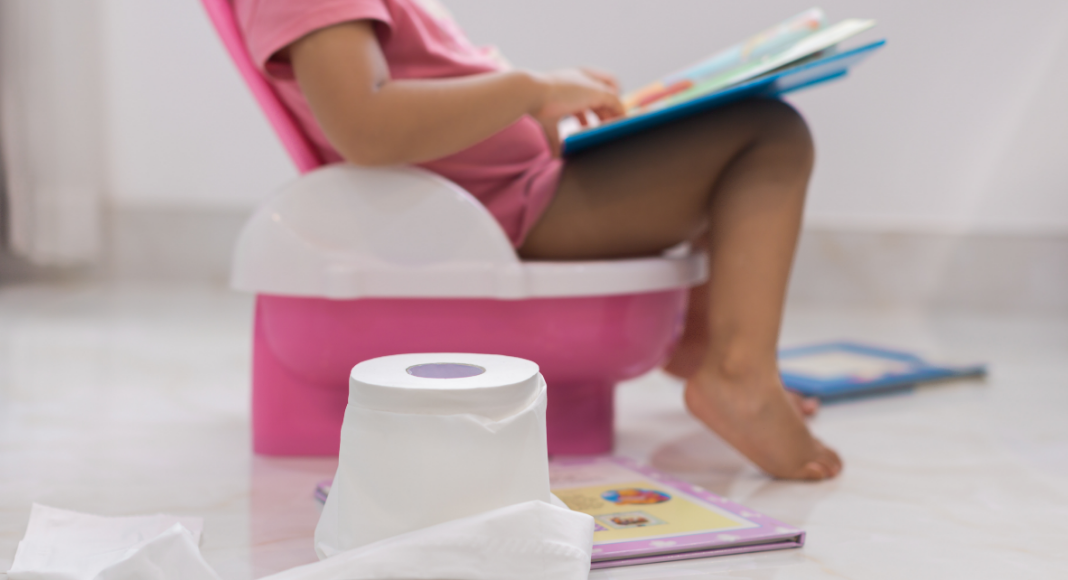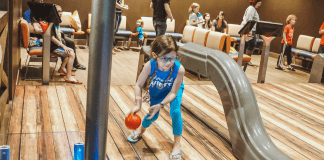I don’t have dozens of my own kids but I did own a daycare for a few years (and do have six kids myself), so I am speaking from experience here. One of the daycare moms once told me that if I ever quit daycare, I should become a professional potty trainer! I’ve had a fair mix of boys and girls and have found that one isn’t necessarily easier than the other.
One of the most important steps is to make sure that the child is completely ready to potty train.

This usually happens between the ages of 2 and 3. Oftentimes, parents are over-anxious and the child isn’t fully ready. This leads to lots of frustration on both sides. See some of the signs that they are ready below (Note – every child is different and what works for one, may not work for the other):
- Ability to stay dry during naps and through the night
- Can pull their pants up and down
- Is interested in the potty and/or other people using it
- Doesn’t like having a dirty diaper
- Can give a sign (physical or verbal) that they have dirtied their diaper
- Seeks independence
- Can follow simple directions (i.e. shut the door, bring me the toy, etc.)
- Has a desire to accomplish things
After they start showing the signs, make sure that you talk to them about potty training prior to starting. When you change their diaper, say what they did, tell them that we’re going to start putting it in the potty. Tell them after the diapers run out, that we’re going to start using the potty. Tell them that you’re going to throw/give away the rest of the diapers and let them watch you do it so they know that they’re really gone.
The best advice and secret that I was given came from my grandmother-in-law… ”Just put them in underwear and let them go!” They quickly realize that they don’t enjoy the feeling of being wet/dirty. There will be messes to clean up and extra laundry to do, but it is only for the first two to three days. By day three, if they aren’t getting it at least a little bit, they aren’t ready. If they are getting it, DO NOT go back to diapers.
I am also not a fan of Pull-Ups, for any reason. They significantly hinder the process and confuse the child. You should make sure that you have the time to work with your child to learn this new skill. Do not send them to daycare on day one (or even day two) of potty training (and check with your daycare on their policies). Start on a weekend if you need to. Do not put them in Pull-Ups at naptimes or bedtime. They need to learn the skill of holding it.
As I mentioned before, if they aren’t able to do this, or you aren’t ready for the extra messes for a couple of days, don’t start the process. At nap and bedtime, get them up a few minutes before they’d normally be up and take them directly to the potty. Don’t start potty training when you have errands to run or events to go to. You need to dedicate at least two to three days to this.
Each child is different and learns in their own way.
The type of potty used will be up to you and your child. Some prefer the free-standing potty chair, some like the potty seat, some just like the regular toilet. Some boys prefer to start out sitting, some standing. Be sure to praise, praise, praise! Praise them for signaling that they need to go (or just went), praise them for walking into the bathroom, praise them for sitting on the potty even if for only a second. Give exaggerated praise if they actually go in the potty. Sing a silly potty song, do a dance, give extra kisses and hugs, whatever works for them.
Children crave one-on-one time with their parents/caretakers and love to please them. When they see how happy you are, they will want to repeat it. Some children need more than praise and that’s okay. I’ve used everything from watching a favorite show to stickers, to getting one M&M for using the potty.
You will need to ask them frequently (like every few minutes) if they need to use the potty. For the first few days, if it’s been more than 20 minutes, take them to the potty and let them sit there for a few minutes to try to go. If you’re wondering what to do while sitting there and waiting for them to go, read a book with them, talk to them about their day, tell them a story, let them draw a picture, sing with them, anything to get them to sit there for a few minutes.
If they don’t go, don’t be harsh with them. Let them know that it’s okay and you’ll try again in a little bit. You definitely don’t want them associating the potty with something negative. It is okay to show a small, teeny, tiny bit of disappointment if they don’t make it to the potty after the first day (by saying something like “Oh no, we could have put that in the potty” and follow with something positive like “Maybe the next time we’ll get it there” or give them a hug).
If after following these steps and having a few days with lots of accidents, they may not be fully ready. This should be the only time that you would go back to diapers. This isn’t a failure on either side. They’re just not fully ready. Try again in a few weeks. It allows for a break and they will have already been introduced to the idea and may “get it” a lot quicker the second time around.
There will be some tears (maybe from everyone involved) but don’t let it discourage you or them; this is a huge skill to master. Have patience and compassion and know that there is an end in sight and one day (hopefully very soon), they will use the toilet without a hitch.
Teaching these life skills is hard but you’ve got this! Kudos to you and good luck!












